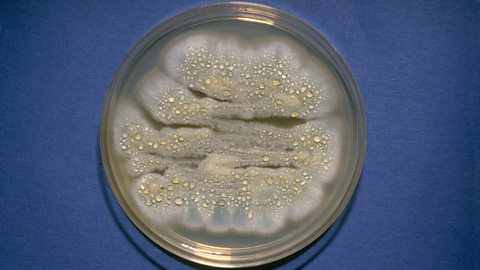Evidence for evolution - antibiotic resistance in bacteria
Antibiotic resistance
Bacteria can evolve quickly because they reproduce at a fast rate. Mutations in the DNA of bacteriaSingle-celled microorganisms, some of which are pathogenic in humans, animals and plants. Singular is bacterium. can produce new characteristics. A random mutation might cause some bacteria to become resistant to certain antibioticSubstance that controls the spread of bacteria in the body by killing them or stopping them reproducing., such as penicillin. Antibiotics usually kill bacteria, but in this case the mutation means the bacteria cannot be destroyed by the antibiotic. The emergence of antibiotic resistance in bacteria is an example of natural selectionThe natural process whereby the best-adapted individuals survive longer, have more offspring and thereby spread their characteristics. Sometimes referred to as 'survival of the fittest'.leading to evolutionThe process of change in the inherited traits of a population of organisms from one generation to the next..
Development of antibiotic resistance
The main steps in the development of antibiotic resistance in bacteria are:
- a random mutation occurs in the DNA of individual bacterial cells
- the mutation protects the bacterial cell from the effects of the antibiotic - it becomes antibiotic resistant
- bacteria without the mutation die when the antibiotic is present
- antibiotic resistant bacteria survive and can reproduce with less competitionThe interaction between organisms after the same limited resources. from non-resistant bacterial strains
- the genes for antibiotic resistance are passed to the offspring
- over time the whole population of bacteria becomes antibiotic resistant because the antibiotic resistant bacteria are best suited to their environment
MRSA
The number of resistant strains has increased, partly due to the misuse of antibiotics. This has resulted in more bacterial infections that are difficult to control.
MRSA is methicillin-resistant Staphylococcus aureus. It is a very dangerous bacteria because it is resistant to most antibiotics and so if someone gets infected with MRSA they cannot be treated easily.
In order to reduce the rate of development of antibiotic resistant strains:
- doctors should not prescribe antibiotics inappropriately, such as for the treatment of non-serious infections
- patients should always complete the full course of antibiotics to ensure all bacteria are killed and none survive to mutate and form resistant strains
- the agricultural use of antibiotics should be restricted

Penicillin was the first antibiotic to be produced on a mass scale in the 1940s. It is derived from Penicillium fungi, shown here growing on an agar plate.
Many new types of antibiotics were discovered during the 1950s and 1960s, but the rate of discovery has slowed greatly more recently. Many scientists even stopped looking for new antibiotics, as they felt it was unnecessary.
Recent concerns about increasing antibiotic resistance have created a drive for new antibiotics. However, their development is costly and takes a long time. Some scientists fear that we are fighting a losing battle against antibiotic resistant bacteria, which may ultimately lead to people dying from simple infections.
Explore the evidence for evolution with Dr Alex Lathbridge.
Listen to the full series on ±«Óătv Sounds.
Explore the evidence for evolution with Dr Alex Lathbridge.